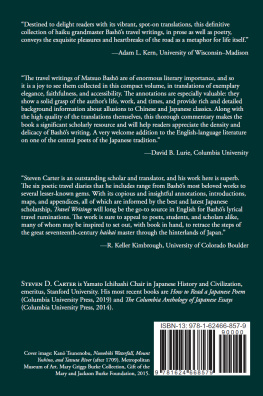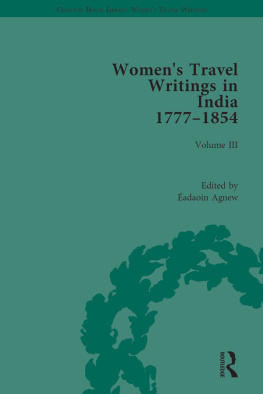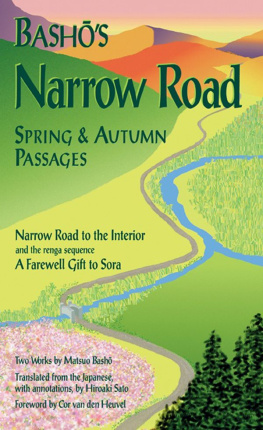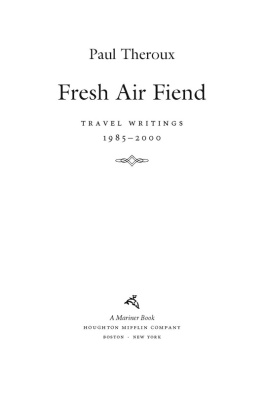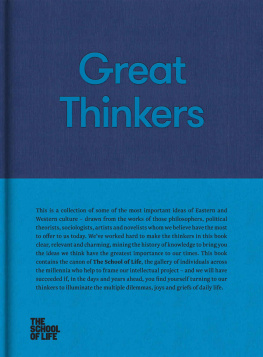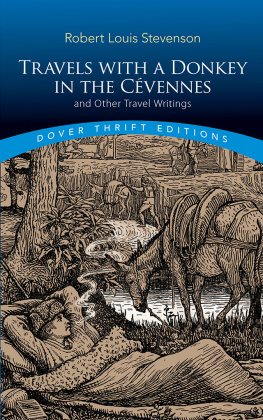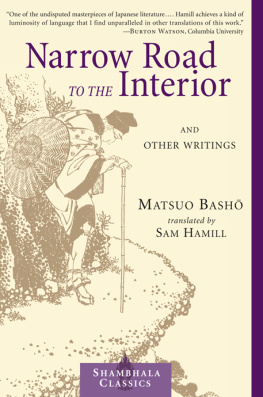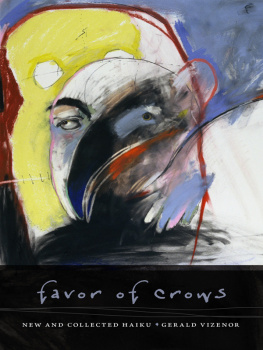Basho Matsuo - Travel Writings
Here you can read online Basho Matsuo - Travel Writings full text of the book (entire story) in english for free. Download pdf and epub, get meaning, cover and reviews about this ebook. year: 2020, publisher: Hackett Publishing Company, Incorporated, genre: Detective and thriller. Description of the work, (preface) as well as reviews are available. Best literature library LitArk.com created for fans of good reading and offers a wide selection of genres:
Romance novel
Science fiction
Adventure
Detective
Science
History
Home and family
Prose
Art
Politics
Computer
Non-fiction
Religion
Business
Children
Humor
Choose a favorite category and find really read worthwhile books. Enjoy immersion in the world of imagination, feel the emotions of the characters or learn something new for yourself, make an fascinating discovery.
- Book:Travel Writings
- Author:
- Publisher:Hackett Publishing Company, Incorporated
- Genre:
- Year:2020
- Rating:3 / 5
- Favourites:Add to favourites
- Your mark:
- 60
- 1
- 2
- 3
- 4
- 5
Travel Writings: summary, description and annotation
We offer to read an annotation, description, summary or preface (depends on what the author of the book "Travel Writings" wrote himself). If you haven't found the necessary information about the book — write in the comments, we will try to find it.
Travel Writings — read online for free the complete book (whole text) full work
Below is the text of the book, divided by pages. System saving the place of the last page read, allows you to conveniently read the book "Travel Writings" online for free, without having to search again every time where you left off. Put a bookmark, and you can go to the page where you finished reading at any time.
Font size:
Interval:
Bookmark:
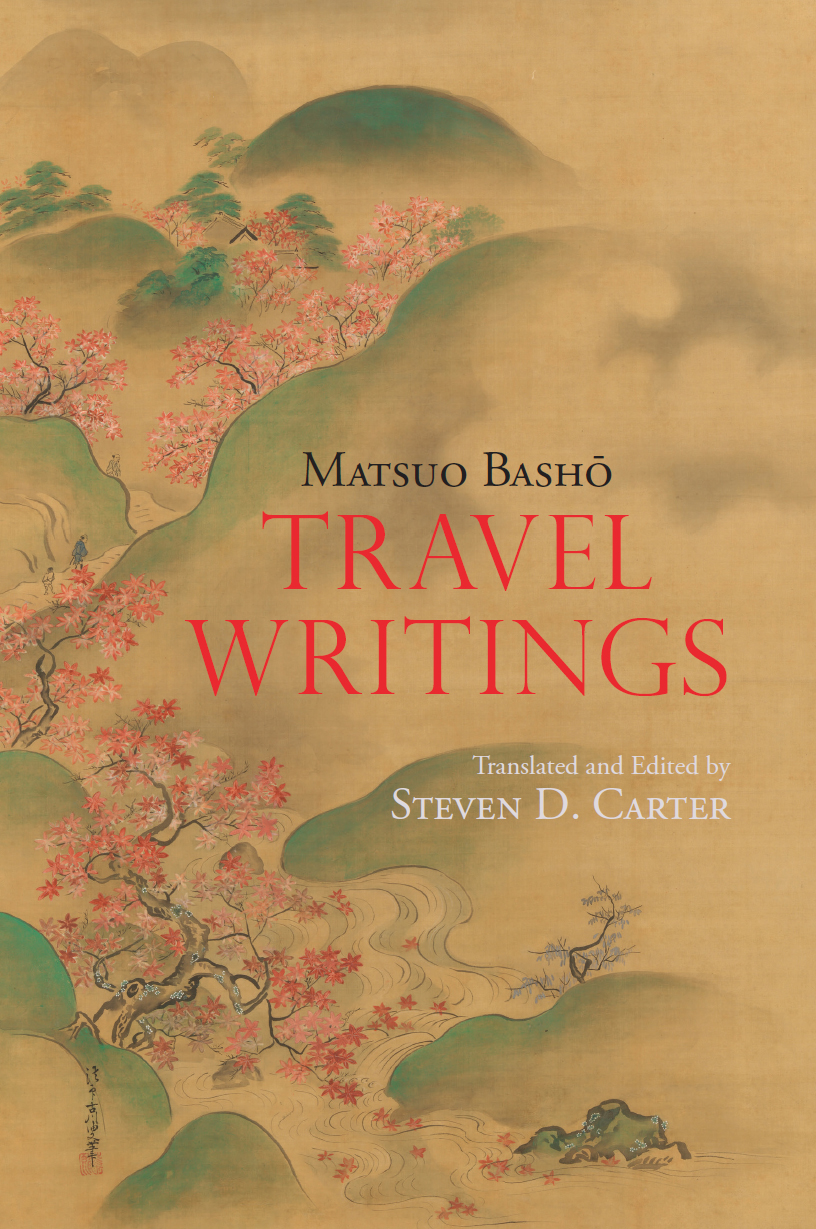
M ATSUO B ASH
TRAVEL
WRITINGS
M ATSUO B ASH
TRAVEL
WRITINGS
Translated and Edited by
S TEVEN D. C ARTER
Hackett Publishing Company, Inc.
Indianapolis/Cambridge
Copyright 2020 by Hackett Publishing Company, Inc.
All rights reserved
Printed in the United States of America
23 22 21 20 1 2 3 4 5 6 7
For further information, please address
Hackett Publishing Company, Inc.
P.O. Box 44937
Indianapolis, Indiana 46244-0937
www.hackettpublishing.com
Cover design by Rick Todhunter and E. L. Wilson
Interior design by E. L. Wilson
Composition by Aptara, Inc.
Maps by Kimball Carter
Library of Congress Control Number: 2019952426
ISBN-13: 978-1-62466-884-5 (hardback)
ISBN-13: 978-1-62466-857-9 (paperback)
ePub3 ISBN: 978-1-62466-930-9
Zen Sourcebook: Traditional Documents from China, Korea, and Japan . Edited by Stephen Addiss, Stanley Lombardo, and Judith Roitman, with an Introduction by Paula Arai.
C. T. Assendelft de Conongh, A Pioneer in Yokohama: A Dutchmans Adventures in the New Treaty Port . Edited and Translated, with an Introduction, by Martha Chaiklin.
Paul H. Clark, The Perry Expedition and the Opening of Japan to the West, 18531873: A Short History with Documents .
To Benjamin and Ella.
A word is dead
When it is said,
Some say.
I say it just
Begins to live
That day.
Emily Dickinson (no. 1212)
Acknowledgments
As always, I thank my wife Mary for encouragement and support. Three anonymous reviewers offered useful comments, and the staff at Hackett Publishing have been kind and accommodating throughout the editing process.
S. Carter
Contents
The page numbers in curly braces {} correspond to the print edition of this title.
This book presents fully annotated translations of the six texts of Matsuo Bash that are generally categorized as travel literature. Numerous English translations exist for some of these texts, particularly Oku no hokumichi ; but earlier translators have not had the benefit of recent developments in Japanese scholarship on Bashs life and travels, which I have been able to consult. I have also included more annotation than most previous translators.
I present the texts in the following order, which is consistent with the practice of Japanese scholars in virtually all editions of the last half century:
Bones Bleaching in the Fields
A Pilgrimage to Kashima
Knapsack Notes
A Journey to Sarashina
The Narrow Road through the Hinterlands
The Saga Diary
Readers will notice that this order is based on the chronological order of the journeys that formed the background of the texts and not of the publication of the texts themselves. The main reason for this is that none of Bashs travel writings was published in his lifetime, and most of the manuscripts have such complicated textual histories that deciding the true order of their completion has seemed impossibleespecially so in the case of Nozarashi kik , Oi no kobumi, and Oku no hosomichi . (See the bibliography for further information about publication history.)
The titles now assigned to these writings were probably not all chosen by Bash, who in particular seems not to have called his travel writings kik , or travel record, and evidently thought of what he produced as new and different (see the Introduction). For this reason, I have chosen to avoid the word record in most contexts, because it can so easily be taken as a quick, crude jotting down of events. Instead I have opted for writing or account or texta step in the right direction in terms of literary connotations, I hope. The word memoir also comes to mind, of course, but that word is so associated in popular discourse with modern conceptions of subjectivity and confession that I hesitate to use it in relation to Bash.
In my translations of the travel writings and in my introductions and appendices, I have generally not translated place names, except when necessary because of puns and other figures of speech or when the literal meaning of a name is directly relevant to the meaning of the text. The exceptions are most mountains (Mount Fuji, Mount Takao, etc.); moors (Saba Moor, Miyagi Moor, etc.); rivers (Fuji River, i River, etc.); roads (Tkai Road); islands (Magaki Island), etc., where I have incorporated the English translation of those general terms. Most place names do have meaningEdo , meaning bay door; Tsuruoka , meaning crane hill; Yamura , meaning valley village; and so onbut as is true with place names generally, literal meanings are irrelevant in most contexts. I have also generally not translated personal names but rendered them in romanized form: Sensui rather than river water, Issh rather than one laugh, and Bash rather than plantain cottage.
Bash and his contemporaries used the lunar calendar, which divided the year into twelve months that closely reflected the phases of the moon, with months being either twenty-nine or thirty days in length. Thus, the Twelfth Month in my translation refers to the twelfth lunar month. Because over time this system did not correlate with the 365 days of the solar year, an intercalary month ( jun -) was periodically added in.
I have included a glossary of literary terms and notes on important people and places in the back matter of the book, along with short essays intended to supplement the introductions and notes.
{xi}
T HE L IFE
In the winter of 1687, at a farewell party, Matsuo Bash composed the following first verse ( hokku ) for a linked-verse gathering:
A traveler | tabibito to |
that is what I shall be called. | waga na yobaren |
First rain showers. | hatsushigure |
Like so many of his hokku , this one ended up doing double duty, appearing later as the first poem in his Knapsack Notes . In the centuries since then, the poem has come to signify the centrality of travel in his poetic practice, and also to define his commitment to experiencing the rigors of the road, symbolized in the poem by rain showers. However, as the journey of 168788 would inspire not the first but the third of his travel writings, one must stress that Bash had become a traveler much earlier. Almost certainly he spent time on the road while still living in his hometown, which was close to the cultural centers of Kyoto, Ise, and Nara. We also know that he took the Tkai Road to Edo in 1672, when he determined to make a career for himself as a haikai poet in that capital city, and that he traveled back to his hometown and to Kyoto in the summer of 1676, not to mention the journeys of 168485 and autumn of 1687, for which he left accounts.
No one would have predicted this future for a man of Bash s origins. He was born the second son of a farmer, Among the literate, skill in such arts was encouraged if not absolutely required, and in this case there were local adherents that provided a ready place for a young man of taste and ability.
Had his patron not died suddenly in 1666, Munefusas life might have turned out differently. He was already in his mid-twenties and might have continued on in clan service of some kind. True, the stipend of his patrons lineage was just He might have gone to Kyoto, but that was a more staid world and less open to new ways. Edo was a lively place, although a riskier market.
In Edo, Bash soon launched a poetic practice under the name Nor did it signal an end to his literary ambitions; if anything he showed more commitment than he had before, especially when it came to linked verse. By 1680 he had twenty-one disciples ( monjin ) and was publishing New Years chapbook anthologies ( saitanch ) for his schoolusing the latter term in the loose sense of disciples who accepted his authority, listened to his counsel, contributed poems to his anthologies ( sh ), and, in many cases, provided financial assistanceand appearing in other publications.
Font size:
Interval:
Bookmark:
Similar books «Travel Writings»
Look at similar books to Travel Writings. We have selected literature similar in name and meaning in the hope of providing readers with more options to find new, interesting, not yet read works.
Discussion, reviews of the book Travel Writings and just readers' own opinions. Leave your comments, write what you think about the work, its meaning or the main characters. Specify what exactly you liked and what you didn't like, and why you think so.

